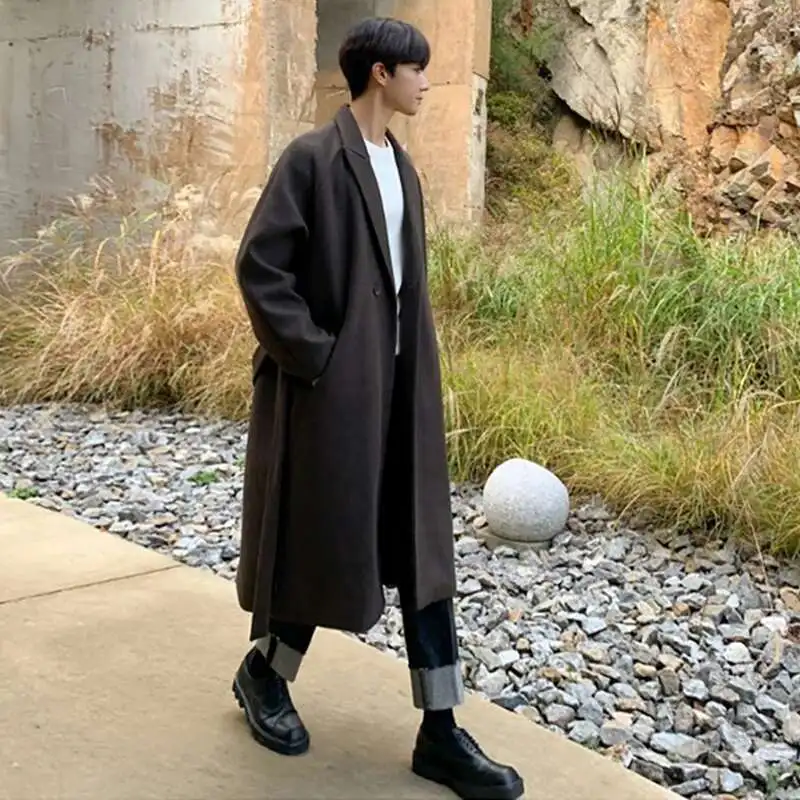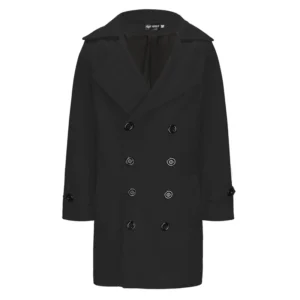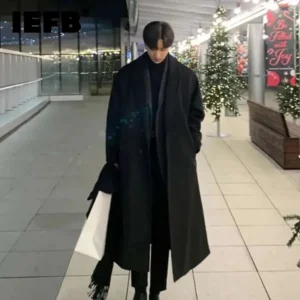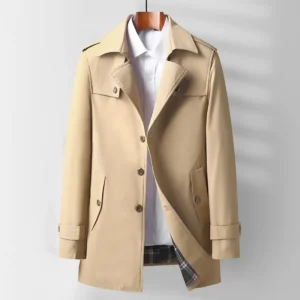The Timeless Appeal of Grey Wool Coats: A Foundation for Sophisticated Style
The grey wool coat stands as one of menswear’s most enduring and versatile investment pieces. More than just outerwear, it represents a foundation for sophisticated style that transcends seasonal trends and fashion fads. Its neutral grey tone creates an ideal canvas that pairs effortlessly with virtually any color palette in your wardrobe, from rich navy blues to burgundy accents and earthy tones.
Wool’s natural properties make it particularly well-suited for a quality coat. This remarkable fiber offers:
– Exceptional warmth without excessive weight
– Natural water resistance and moisture-wicking capabilities
– Impressive durability that improves with proper care
– Breathability that regulates body temperature in changing conditions
The beauty of a well-crafted grey wool coat lies in its dual functionality—it serves as both a practical outer layer for protection against the elements and a refined style statement that elevates your entire look. Understanding the right coat length for your build allows you to maximize both comfort and visual appeal, creating a balanced silhouette regardless of your height or body type.
This comprehensive guide will explore the art of layering with your grey overcoat, providing you with practical strategies to maximize its versatility across occasions, temperatures, and style preferences.
Understanding Your Grey Wool Coat: Types and Features for Optimal Layering
Before diving into specific layering techniques, it’s essential to understand the different varieties of grey wool coats and how their unique features affect your layering options.
Common Grey Wool Coat Styles:
– Overcoats: The classic full-length option (typically reaching below the knee) providing maximum coverage and formality
– Topcoats: Mid-thigh to knee-length coats with a streamlined silhouette, slightly less formal than overcoats
– Peacoats: Shorter, double-breasted options with broader lapels and a nautical heritage
– Chesterfield Coats: Single-breasted options with velvet collars and a clean, structured appearance
Your layering strategy should account for several critical coat features. The shoulder construction significantly impacts how much bulk can comfortably fit underneath—raglan shoulders typically allow for more substantial layers than structured shoulders with defined seams. The length of your coat also determines which inner layers will remain visible; longer coats conceal more, while shorter options require more consideration for how pants and lower layers interact visually.
Single-breasted coats offer more flexibility for casual layering and can be worn open to display inner layers more effectively. Double-breasted options provide additional warmth when closed but create a more formal appearance that sometimes limits casual styling options.
Wool weight, measured in ounces per yard (oz) or grams per meter (g/m), directly impacts your layering capacity. Lighter coats (18-20 oz/510-570g) work better for fall and spring with minimal layers underneath, while heavier options (24-30 oz/680-850g) are designed for winter conditions and can accommodate substantial layering without losing their shape.
The right wool overcoat selection creates the foundation upon which all your layering choices will build.
The Science of Layering: Building Warmth with Style
Effective layering is both an art and a science. The three-layer principle provides a systematic approach to building outfits that maximize both warmth and style:
Base Layer: The foundation that sits directly against your skin, managing moisture and providing initial insulation. Ideal options include:
– Merino wool t-shirts or long sleeves for natural temperature regulation
– Technical fabrics that wick away perspiration
– Fine cotton for moderate temperatures when moisture management is less criticalMid Layer: The insulating component that traps body heat while adding visual interest:
– Lightweight sweaters in cashmere, merino, or cotton blends
– Vests (quilted or knit) for core warmth without sleeve bulk
– Cardigans that add texture and easy adjustment options
– Lightweight sport coats or blazers for structured layeringOuter Layer: Your grey wool coat, which provides weather protection while tying the entire look together visually.
The science behind this approach is simple yet effective—each layer creates an insulating pocket of warm air, while the progression from thin, fitted base layers to slightly roomier outer layers maintains a clean silhouette without restriction. Understanding how warm wool coats are in winter helps you determine exactly how many layers you’ll need for various conditions.
For maximum effectiveness, each successive layer should be slightly thicker than the one beneath it, allowing for natural body movement while preventing bunching or binding. The materials should complement each other functionally, with moisture-wicking properties in your base layer and breathable insulation in mid-layers.
Casual Layering: Everyday Comfort with Your Grey Wool Coat
A grey wool coat naturally brings refinement to casual outfits, creating an elevated weekend look that remains comfortable and practical. The key is balancing the coat’s inherent formality with relaxed pieces underneath.
Weekend Coffee & Errands:
– Base: Heathered cotton henley or lightweight merino t-shirt
– Mid: Medium-weight cotton or wool-blend sweater in a complementary neutral
– Bottom: Dark wash jeans or chinos with slight texture
– Footwear: Clean leather sneakers or casual chukka boots
– Accessories: Simple knit beanie and lightweight scarf
Casual Dinner or Social Gathering:
– Base: Button-down Oxford shirt in white or light blue
– Mid: Shawl-collar cardigan or lightweight quarter-zip pullover
– Bottom: Tailored five-pocket pants or premium dark denim
– Footwear: Chelsea boots or minimal leather sneakers
– Accessories: Patterned scarf that introduces accent color
Weekend Excursion:
– Base: Waffle-knit henley or lightweight flannel shirt
– Mid: Quilted vest or lightweight technical jacket
– Bottom: Rugged chinos or corduroy pants
– Footwear: Leather boots with substantial sole
– Accessories: Leather gloves and casual watch
The casual context allows you to experiment with textures and unexpected combinations while maintaining a cohesive look. Wool blend coats often work particularly well for casual layering as they typically offer a slightly more relaxed drape than pure wool options while maintaining a sophisticated appearance.
Business and Smart Casual Layering: Office-Ready Combinations
Your grey wool coat provides the perfect finishing touch to business and smart casual attire, creating a polished professional appearance while offering practical protection during commutes and outdoor meetings.
Traditional Office Setting:
– Base: Crisp cotton dress shirt in white, light blue, or subtle pattern
– Mid: Navy, charcoal, or burgundy V-neck sweater and/or single-breasted blazer
– Bottom: Wool trousers in complementary neutral tone
– Footwear: Cap-toe oxfords or quarter-brogue dress shoes
– Accessories: Patterned pocket square and leather gloves
Creative Professional Environment:
– Base: Tattersall check or subtle pattern button-down shirt
– Mid: Unconstructed sport coat in navy, burgundy or olive
– Bottom: Chinos or five-pocket pants in complementary neutral
– Footwear: Leather chukkas or clean Chelsea boots
– Accessories: Textured knit tie and leather portfolio or messenger bag
Client Meetings or Business Dinners:
– Base: Spread collar dress shirt in crisp white or light blue
– Mid: Charcoal or navy blazer with subtle texture
– Bottom: Flannel trousers or wool dress pants
– Footwear: Polished whole-cut or cap-toe oxfords
– Accessories: Silk tie with subtle pattern and dress watch
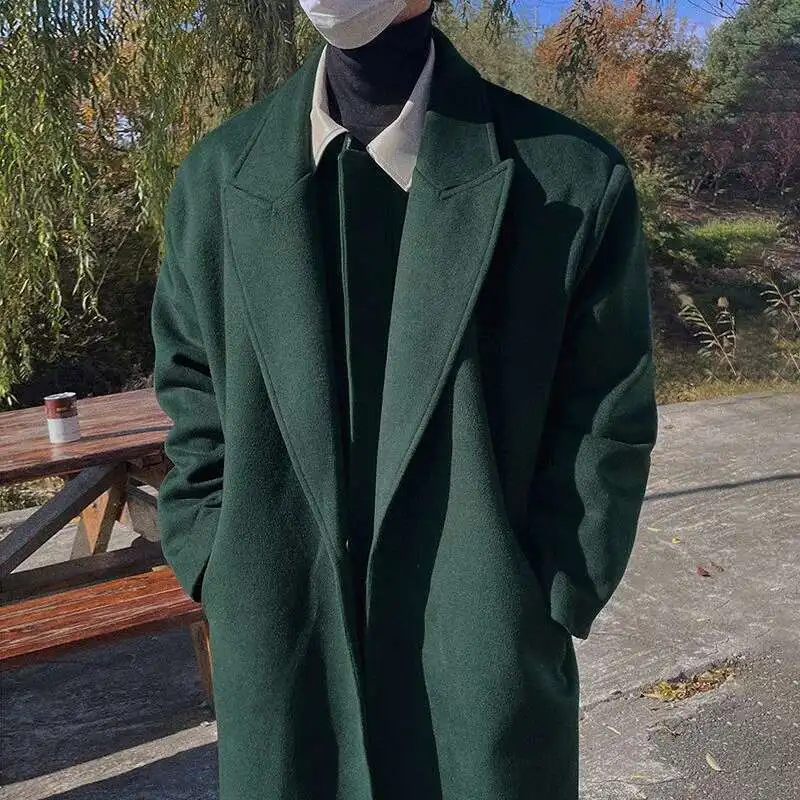
For business settings, attention to proportions becomes especially important. Consider how the short versus long coat options affect your overall appearance—longer coats often project more authority and formality, while shorter options can create a more contemporary business-casual aesthetic.
Formal Layering: Elevating Your Grey Wool Coat for Special Occasions
When formal occasions demand your best presentation, a grey wool coat serves as the perfect finishing touch to refined attire. The coat’s structured silhouette complements formal wear beautifully, creating a cohesive and sophisticated appearance.
Evening Formal Event:
– Base: Crisp white dress shirt with French cuffs
– Mid: Charcoal or black suit with subtle sheen or texture
– Bottom: Matching suit trousers with clean break over shoes
– Footwear: Black patent leather or highly polished oxfords
– Accessories: Silk tie or bow tie, silver cufflinks, and dress watch
Wedding Guest Attire:
– Base: Light blue or pink dress shirt with semi-spread collar
– Mid: Navy or medium grey suit in seasonal weight wool
– Bottom: Matching suit trousers with perfect length
– Footwear: Brown or burgundy cap-toe oxfords
– Accessories: Patterned silk tie, coordinating pocket square, and dress watch
Theater or Fine Dining:
– Base: White or subtle striped dress shirt
– Mid: Charcoal suit or navy blazer with grey flannel trousers
– Bottom: Tailored trousers with slight taper
– Footwear: Wholecut oxfords or opera pumps for ultra-formal events
– Accessories: Silk scarf, dress gloves, and subtle lapel pin
For formal occasions, the fit relationship between your suit and coat becomes critical. Your overcoat should allow enough room to accommodate a suit jacket without restricting movement or creating visible strain across the shoulders or when buttoned.
Seasonal Layering Strategies: Adapting to Temperature Changes
Mastering seasonal layering allows you to maximize your grey wool coat’s versatility throughout the year, adapting to varying temperatures while maintaining style.
Mild Weather (50-60°F / 10-15°C):
– Base: Lightweight cotton or merino t-shirt or dress shirt alone
– Mid: Light sweater or unlined blazer (optional)
– Coat: Worn unbuttoned for ventilation
– Strategy: Minimal layering with focus on style rather than insulation
– Adaptation: Roll or push up sleeves on inner layers for temperature regulation
Moderate Cold (30-50°F / -1-10°C):
– Base: Lightweight merino or technical base layer
– Mid: Medium-weight sweater, cardigan, or lined blazer
– Coat: Buttoned with scarf as optional neck insulation
– Strategy: Focus on quality mid-layers that provide warmth without bulk
– Adaptation: Carry gloves and hat to add/remove as needed
Severe Cold (Below 30°F / -1°C):
– Base: Thermal or heavy merino base layer
– Mid: Heavy sweater plus insulated vest or lightweight down jacket
– Coat: Fully buttoned with functional accessories
– Strategy: Multiple thin layers rather than fewer bulky ones
– Adaptation: Technical fabrics in base layers to manage moisture during transitions
Light topcoats designed for effortless layering offer particular versatility during transitional seasons when temperatures fluctuate throughout the day. For winter conditions, focus on creating sealed openings at wrists, neck, and waist to prevent heat escape.
Mastering Textures and Fabrics: Creating Dimension with Your Grey Wool Coat
The visual impact of layered outfits comes largely from thoughtful texture combinations. Your grey wool coat provides an excellent foundation for exploring complementary textures that add depth and sophistication to your appearance.
Texture Principles for Effective Layering:
– Contrast smooth with rough textures for visual interest
– Balance weights appropriately for the season
– Use texture to differentiate between similar colors
– Create rhythm by repeating textural elements subtly
Complementary Fabric Pairings:
– Smooth wool coat + chunky cable knit sweater + oxford cloth shirt
– Textured wool coat + fine gauge merino sweater + broadcloth dress shirt
– Herringbone wool coat + cashmere turtleneck + flannel trousers
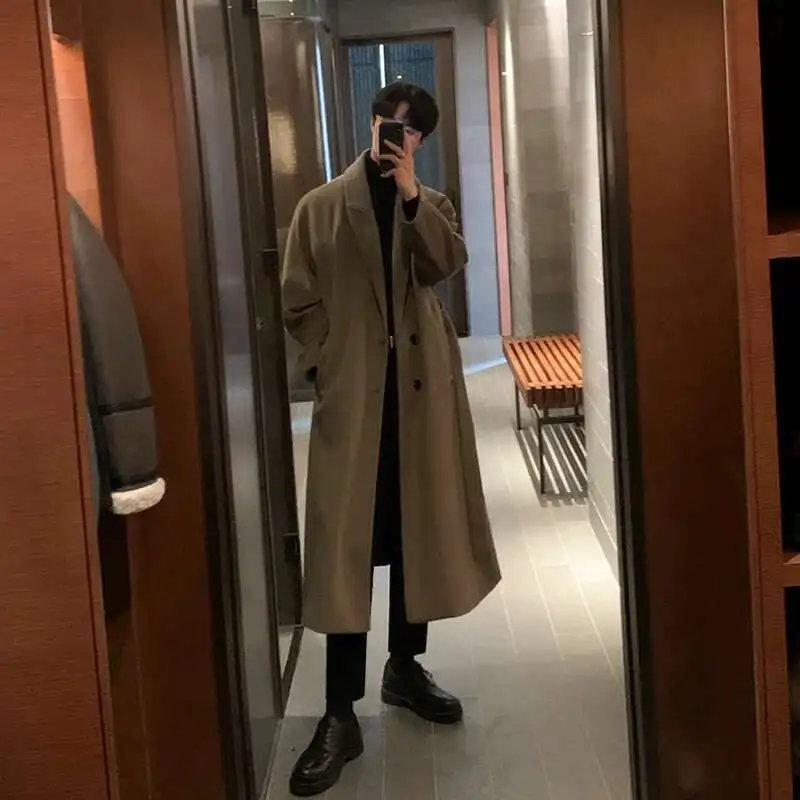
Seasonal fabric considerations enhance both comfort and visual appropriateness. Lighter, more breathable fabrics work well in fall and spring, while denser, more substantial textures feel right for winter. A herringbone coat offers particular textural interest that pairs beautifully with both smooth and textured accompaniments.
Remember that texture affects perceived formality—smoother fabrics generally read as more formal, while pronounced textures create a more casual impression. This principle allows you to adjust the formality of your grey wool coat through thoughtful inner layer selections.
Strategic Accessories: Enhancing Your Grey Wool Coat
The right accessories not only provide practical benefits but also personalize your grey wool coat, enhancing its versatility across different contexts and style preferences.
Scarf Selection and Styling:
– Cashmere for luxury and exceptional warmth
– Wool for durability and traditional appearance
– Silk for formal occasions and lightweight insulation
– Cotton or linen blends for transitional seasons
Hat Options by Formality Level:
– Formal: Felt fedora or wool newsboy cap
– Smart-casual: Wool flat cap or minimalist beanie
– Casual: Textured knit beanie or baseball cap in wool or canvas
Glove Considerations:
– Lined leather for business and formal wear
– Suede for smart-casual styling
– Knit wool or technical materials for casual contexts
– Convertible or touchscreen-compatible options for practicality
Bag Coordination:
– Leather briefcase or document holder for business settings
– Structured messenger bag or satchel for daily commuting
– Canvas and leather weekender for casual travel
– Minimal portfolio for meetings and formal occasions
The beauty of accessories lies in their ability to transform your coat’s presentation without requiring a complete outfit change. Drawing inspiration from grey overcoat street style can help you discover creative accessorizing approaches that align with contemporary trends while respecting classic principles.
Avoiding Layering Pitfalls: Troubleshooting Common Issues
Even the most carefully selected layers can present challenges. Understanding common layering problems and their solutions ensures your grey wool coat outfits maintain their refined appearance.
Challenge: Excess Bulk and Restricted Movement
Solution: Choose thinner, higher-quality layers rather than fewer bulky ones. Technical fabrics and premium wools provide warmth without volume. Ensure each layer is incrementally larger than the one beneath it, allowing for natural movement.
Challenge: Visible Layer Lines and Bunching
Solution: Select smoother, more fitted base and mid-layers. Tuck or smooth layers before putting on your coat, and adjust throughout the day. Consider the perfect coat length for your height to ensure proportional harmony.
Challenge: Overheating During Transitions
Solution: Incorporate layers that are easy to remove, like buttoned cardigans, vests, or quarter-zip pullovers. Choose natural fibers that breathe well and regulate temperature naturally.
Challenge: Inconsistent Hem Lengths
Solution: Coordinate the length of visible layers intentionally. Generally, inner layers should be shorter than outer ones, creating a pleasing graduated effect. For formal looks, ensure shirt cuffs extend precisely 1/4 to 1/2 inch beyond jacket sleeves.
Challenge: Collar Management
Solution: Decide whether to display or hide inner layer collars based on formality and style intent. For dress shirts under sweaters, the “collar in” approach reads as more casual, while “collar out” creates a more polished appearance.
Care and Maintenance: Ensuring Your Layered Looks Stay Perfect
Proper care ensures your grey wool coat and layering pieces maintain their appearance and functionality for years to come.
Wool Coat Care Essentials:
– Hang on a sturdy, shaped wooden hanger when not in use
– Allow 24-hour rest periods between wearings
– Brush with a clothes brush after each wear to remove surface debris
– Spot clean minor stains immediately with a damp cloth
– Professional dry cleaning only 1-2 times per season to prevent damage
– Store properly during off-season in breathable garment bag
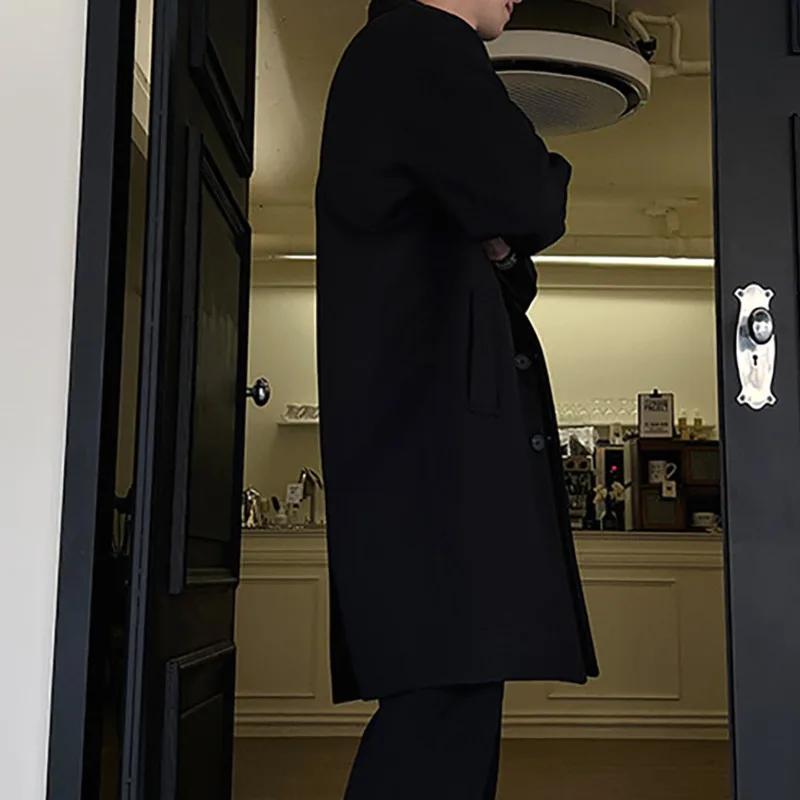
Maintenance for Common Layer Fabrics:
– Wool sweaters: Hand wash or gentle machine cycle with wool-specific detergent, dry flat
– Cotton shirts: Machine wash in cold water, hang or tumble dry on low heat
– Technical fabrics: Follow manufacturer instructions, generally machine washable
– Fine knits: Hand wash or mesh bag in gentle cycle, reshape and dry flat
Emergency Care on the Go:
– Carry a lint roller for quick touch-ups
– Blot (don’t rub) liquid spills immediately with clean napkin or handkerchief
– Keep collar stays in dress shirts to maintain crisp appearance
– Use portable fabric brush for removing surface dust from wool
Mens Double Breasted Pea Coat, Mens Wool Blend Coat, Mens Wool Pea Coat
Price range: $136.84 through $157.36 Select options This product has multiple variants. The options may be chosen on the product pageMens Cashmere Overcoat, Mens Hooded Winter Coat, Mens Wool Blend Coat
Price range: $128.72 through $139.68 Select options This product has multiple variants. The options may be chosen on the product pageMens Black Overcoat, Mens Black Wool Coat, Mens Wool Overcoat
$339.18 Select options This product has multiple variants. The options may be chosen on the product pageMens Grey Overcoat, Mens Wool Blend Coat, Mens Wool Overcoat
$201.28 Select options This product has multiple variants. The options may be chosen on the product pageMens Herringbone Coat, Mens Long Overcoat, Mens Wool Overcoat
Price range: $197.16 through $203.69 Select options This product has multiple variants. The options may be chosen on the product pageMens Long Overcoat, Mens Topcoats
Price range: $189.40 through $196.88 Select options This product has multiple variants. The options may be chosen on the product page
Beyond Basics: Advanced Layering Techniques for Style Enthusiasts
Once you’ve mastered fundamental layering principles, explore these advanced approaches to elevate your grey wool coat styling even further.
Monochromatic Layering:
Build sophisticated depth by combining various shades of grey from charcoal to light heather. The subtle variations in tone create a refined, cohesive appearance that highlights texture and cut rather than color contrast.
Unexpected Layer Types:
– Fine-gauge turtleneck under a casual shirt (worn open)
– Lightweight technical vest between dress shirt and blazer
– Denim or chambray shirt as a mid-layer under sweaters
– Knit sport coat as a mid-layer under your wool coat
Contemporary Proportion Play:
Experiment with oversized scarves, longer inner layers, or slightly cropped pieces to create intentional silhouette variations that maintain harmony while adding visual interest.
Fabric Mixing Innovation:
Combine traditionally separate categories like tailored and athletic pieces—a technical merino quarter-zip under a tweed sport coat under your grey wool coat creates an unexpectedly harmonious blend of performance and tradition.
Color Theory: Complementary Palettes for Your Grey Wool Coat
Your grey wool coat serves as a neutral foundation that works beautifully with virtually any color palette. Understanding color relationships helps you create intentional, harmonious combinations.
Classic Neutrals Palette:
– Navy, charcoal, camel, and cream create timeless, sophisticated combinations
– Varying textures prevent neutral combinations from appearing flat
– Ideal for professional settings and formal occasions
Rich Accent Palette:
– Burgundy, forest green, mustard, and deep purple add refined color interest
– Limit bold colors to one or two pieces within the outfit
– Most effective in mid-layers and accessories rather than base layers
Cool Tones Palette:
– Blues, greys, and silver tones create a cohesive, contemporary aesthetic
– Particularly flattering with blue-undertone grey coats
– Creates a clean, minimalist appearance suitable for modern contexts
Warm Accent Palette:
– Rust, cognac, amber, and bronze add warmth and visual interest
– Especially effective during fall and winter seasons
– Creates pleasing contrast with the cool undertones of many grey wools
The perceived warmth or coolness of your specific grey coat should influence your color choices—warmer greys (with brown undertones) pair naturally with earth tones, while cooler greys (with blue undertones) complement jewel tones and navy beautifully.
When to Layer and When to Let the Coat Stand Alone
Discerning when to embrace layering and when to let your grey wool coat stand independently comes down to understanding both practical needs and style context.
Minimal Layering Scenarios:
– Brief outdoor transitions between heated environments
– Formal occasions where silhouette cleanliness is paramount
– Mild weather conditions when the coat provides sufficient warmth
– Showcasing the coat itself as the focal point of your outfit
Substantial Layering Scenarios:
– Extended outdoor activities in cold weather
– Day-long events with varying environmental conditions
– Casual contexts where layering adds desired visual complexity
– Situations requiring adaptation to changing temperatures
The social context also provides important cues—business and formal settings typically favor cleaner, more minimal layering, while casual and creative environments welcome more visible and complex layer combinations.
Consider your specific coat’s weight and construction as well. Heavier wool coats may require less substantial layering for warmth, while lighter options benefit from more intentional insulation layers underneath.
Questions About Grey Wool Coat Layering: Addressing Common Concerns
Can I layer a puffer jacket under a wool coat?
Yes, but choose a slim, low-profile puffer designed as a mid-layer rather than a standard puffy jacket. The puffer should be shorter than your coat and fitted enough to maintain your coat’s clean lines without creating excessive bulk.
How can I layer for rain protection without spoiling my look?
Rather than trying to make your wool coat waterproof, consider a lightweight, packable technical rain shell that fits over everything for genuine downpours. For light rain, treating your wool coat with appropriate water repellent and carrying a compact umbrella offers the best combination of style and protection.
Is it acceptable to layer a hoodie under a wool coat?
Yes, particularly in casual contexts. Choose a fitted, higher-quality hoodie in a complementary color and ensure the hood lies flat against your back inside the coat. This combination works especially well with more casual coat styles like peacoats or shorter wool coats.
How do I prevent my scarf from creating bulk around my neck and collar?
Use thinner scarves made from fine wool, cashmere, or silk rather than chunky knits for formal and business looks. Master a few streamlined tying techniques like the once-around or the simple drape for elegance without excess volume.
Can I wear a suit jacket and wool coat together comfortably?
Absolutely, but your coat should be specifically sized to accommodate this combination. Ensure you can comfortably button the coat when wearing a suit jacket underneath, and pay attention to sleeve alignment—both jacket and shirt cuffs should be visible in proper proportion.
Quick Reference Guide: Layering Formulas for Your Grey Wool Coat
| Temperature | Occasion | Base Layer | Mid Layer(s) | Accessories |
|---|---|---|---|---|
| 55-65°F (13-18°C) | Casual | Cotton t-shirt or henley | Light cotton sweater | Light scarf (optional) |
| 55-65°F (13-18°C) | Business | Cotton dress shirt | Lightweight blazer | Pocket square |
| 40-55°F (4-13°C) | Casual | Long sleeve henley or flannel | Medium sweater or light vest | Beanie, lightweight scarf |
| 40-55°F (4-13°C) | Business | Dress shirt | Sweater + blazer | Leather gloves, silk scarf |
| 25-40°F (-4 to 4°C) | Casual | Thermal or merino base | Heavy sweater + vest | Wool scarf, hat, lined gloves |
| 25-40°F (-4 to 4°C) | Business | Dress shirt + undershirt | Sweater + suit jacket | Cashmere scarf, leather gloves |
| Below 25°F (below -4°C) | Any | Technical or wool base | Heavy sweater + insulated vest or light down jacket | Full winter accessories set |
This guide provides starting points rather than rigid rules—adjust based on your personal temperature sensitivity, activity level, and specific garment weights. Remember that proper fit throughout all layers remains essential for both comfort and appearance regardless of temperature or occasion.

